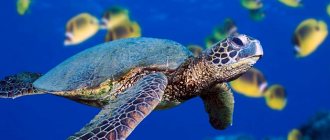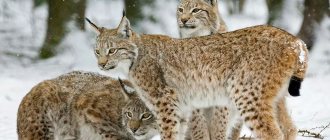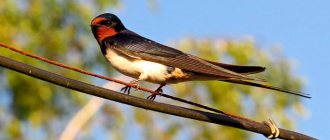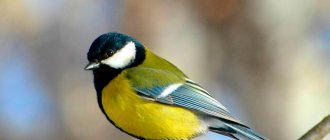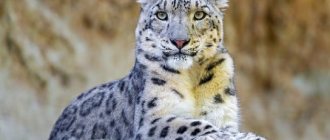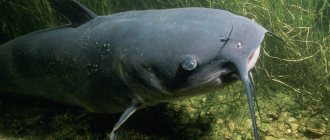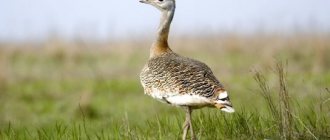- Encyclopedia
- Animals
- Turtle
Turtles are one of the ancient animals. The exact date of their appearance has not been established, but most scientists determine that they are more than 220 million years old.
Turtles have a shell that covers their back and abdomen and provides protection. The shell has holes in the back and front through which they can stick out their head, tail and limbs at the right time. They have no teeth; they have a sharp beak, thanks to which they swallow food whole.
Turtles are calm, peaceful animals. They are slow in their actions, but sea turtles are excellent swimmers, and land turtles move quickly.
The color of turtles matches their habitat, which is protection from their enemies. Sensing danger, turtles hide their limbs in their shells. The lifespan of turtles is more than 100 years. But, according to scientists, some can live 200 years.
Turtles reproduce by eggs. With their hind paws they dig a hole, lay eggs there and fill the hole, compacting it, and immediately leave this place. They do not hatch or care for their young.
Eggs heated by the sun give birth, hatching into babies that take care of themselves without requiring help. An interesting fact is that sea turtles lay their eggs in the place where they themselves were once born.
There are terrestrial and sea turtles. Those that live on land are also divided into land animals and those that live in fresh water bodies.
Sea turtles live in water almost all the time and are excellent swimmers. Their size sometimes exceeds 2 meters and their weight is large. Instead of paws they have flippers. Sea turtles feed on fish, mollusks, crustaceans, and algae.
Freshwater turtles live in rivers, lakes, and swamps. They can breathe through their lungs, so they often come out onto land to bask in the sun. They also move well on land, which cannot be said about their sea counterparts. Being predators, they eat fish and also feed on shellfish and plants.
Land turtles live in arid areas - forests, mountains, deserts. They have an oval convex shell, which makes it possible to hide their head and paws in it in case of danger. They have claws on their paws. They feed on plants, but some can eat insects. They move slowly. Many of their varieties hibernate.
Turtles are common in tropical and temperate climates. People eat many varieties of them. But we should not forget that there are also poisonous turtles.
Option 2
Together with crocodiles, snakes and lizards, turtles belong to the order of reptiles or reptiles. There are more than 300 species. Among the turtles there are many marine inhabitants, some living on land or in freshwater bodies. They inhabit areas with tropical or temperate climates.
The most striking distinctive feature of these animals is their shell, which consists of a dorsal and abdominal half. It performs a protective function and is able to withstand a load 200 times greater than the animal’s own weight. The shell comes in various colors, with ridges and teeth. In newly born turtles it is soft and hardens over time.
The largest is the leatherback turtle, its shell reaches 2.5 m in length and weighs up to 1 ton. Sea turtles are usually larger than freshwater turtles. The largest land turtles are elephant tortoises that live on the Galapagos Islands, weighing up to 400 kg and up to 2 m long. The smallest is the Cape speckled tortoise, weighing no more than 250 g and having a length of up to 12 cm.
These reptiles have no teeth; they bite off food with a hard beak. Turtles have good color vision, which helps them recognize food; smell is of secondary importance. Land turtles react most to red shades; they prefer plant foods. Marine representatives are predators, feeding on fish and shellfish.
If the turtle is in danger, it pulls its head into its shell, additionally covering it with thick front paws.
Turtles are oviparous animals. Moreover, after laying eggs, the female does not show concern for her offspring; only some species guard the clutch of eggs until the babies hatch. Turtles live separately. They are truly long-lived among vertebrates, many of them live 150-200 years.
Due to the fact that turtle meat is a delicacy, their numbers are greatly reduced. 228 species are listed in the Red Book. They are also hampered by environmental pollution and transport. Turtles are often kept as pets because they pose no threat to humans. Very rarely, some species can bite. Eating poisonous jellyfish or mushrooms can cause turtle meat to become toxic and cause poisoning in humans.
2nd, 3rd, 7th grade. The world. Biology
Captivity
Turtles are one of the most favorite pets for children. They are small, interesting looking and you can watch them for a long time. But in order for your pet to be happy for several years, you need to provide him with conditions for existence .
To begin with, the turtle will need an aquarium with a volume of at least 100 liters. A filter is installed in it. To keep the container clean, the water is changed several times a month, after which it is left to settle.
An island must be installed in the aquarium. The light of a special lamp is directed at it, which allows you to replace the sun. If you plan to keep several turtles, then they should be the same size . Large individuals can bite and eat small animals.
For feeding, you can use ready-made mixtures or create your own diet. It includes river fish, pieces of lettuce, cabbage, and seaweed. Young individuals are fed every day, adults once every 3 days.
Caring for a turtle is simple. You need to regularly clean the aquarium and change the water. Sometimes the red ear's claws need to be trimmed. In captivity, an animal can live for several decades. Such a pet does not take up much space, is easy to care for and looks unusual.
↑ Land turtles
Land animals can be found in forests, deserts, and mountains. They have an oval and high shell, they can pull its head and strong limbs inside. Sea and freshwater turtles cannot do this.
Their diet consists mainly of plant foods. Some eat insects, caterpillars, snails and worms. Offspring are born once a year. Many people hibernate.
Land turtles include: Radiated tortoise, Central Asian tortoise (steppe), Giant tortoise and others.
Nutrition, population situation
Small sea turtles feed on zooplankton and small nekton, while adult turtles prefer plant food. Despite the fact that during the mating season these animals migrate far into the ocean, their main habitat is in the coastal zone.
Sea turtles are omnivores.
At a depth of ten meters, the sea turtle finds a variety of plant food. In addition to various algae, the diet of turtles includes mollusks and jellyfish. Sea turtles attack those inhabitants of coastal waters that are even slower than themselves. This species chooses sea caves for recreation.
Since ancient times, the main destroyer of sea turtles has been man. People have always had a huge commercial interest in these leisurely inhabitants of the deep sea because of their tasty meat. Sea turtle eggs were considered a delicacy and a huge number of clutches were destroyed.
Sea turtles are mercilessly exterminated by poachers.
All this, along with the low survival rate of young animals, led to a sharp decline in the population of these unique armored animals. Currently, there is a ban on hunting sea turtles, however, this law is difficult to enforce in large expanses of ocean. In this regard, the population of sea turtles is not high and leaves much to be desired.
Interesting answers
The short-eared owl belongs to the order Owlidae. One of the most numerous subspecies, this species is minimally endangered.
The Moscow Zoo can rightfully be considered one of the favorite places for both residents and guests of the capital, because it was not only the first in Russia, but also the largest. It was opened in 1864.
1826 - born into a noble family in the Tver province. The first education was received at home (in the beginning - as a serf teacher Pavel Sokolov, later - as a governess, whose role was successfully performed by the elder sister of the writer.)
Poland is a fairly large country. It is rich in history, ancient monuments, and beautiful landscapes. The Poles are quite hospitable people. Every tourist will find something to his liking
Source
↑ Sea turtles
Sea turtles live in tropical and subtropical waters and spend almost their entire lives in the water. They have a flattened shell with horny scutes. They swim and dive well and can stay under water for a long time.
The limbs are flippers, with the front ones being larger than the back ones. They have hard jaws that can bite through caught prey. They feed on plankton, crustaceans, mollusks, jellyfish and fish. Many people willingly eat algae.
They lead a solitary lifestyle, but actively communicate with each other. The female comes to land to lay eggs; she moves clumsily and slowly. She sails to the shore where she herself was once born. Sea turtles include: Leatherback turtle, Green turtle, Hawksbill turtle and others.
WHERE IS IT FOUND?
Green turtles prefer warm seas, where their main food grows - seaweed, especially thalassia and zoster. Turtles go to the open sea only during the mating season, traveling to egg-laying sites. The rest of the time they stay in coastal areas. Green turtles swim well and deftly, cutting through the water with their powerful flippers. The movement of turtles resembles the flight of large birds of prey. Green turtles float quite easily on the water. They can spend up to five hours underwater without surfacing.
Report No. 2
This American freshwater reptile occupies one of the leading places in the ranking of pets. It is believed that these animals come from the South American country of Peru.
Appearance and main characteristics
This type of turtle is relatively small in size - from 18 to 30 cm. Male red-eared turtles are smaller than females. At an early age, their shell is green in color, then darkens to an olive or brown color with yellow stripes. Her head, neck and paws seem to be painted with green and white spots and uneven stripes. There is a scarlet spot near each of the animal’s eyes. Hence its name - red-eared. Sometimes the color of the spot may be more orange or even yellow.
These turtles do not have a voice, but they can snort in moments of danger, when they are afraid, and can even whistle or squeak. Hearing is very weak. But the sense of smell and vision, on the contrary, are very well developed.
Habitats
Red-eared turtles love wetlands: shallow lakes, ponds with low banks. She moves little. The main thing is to be well-fed. If the turtle has eaten well, all he can do is rest. Why does she crawl onto the shore of the reservoir and bask in the warm sun? Her well-being depends on the temperature of the water in which she is located. When the temperature is below 18, she becomes uneasy, her appetite may disappear and her general condition is weak.
Diet, reproduction
Turtles reproduce by laying eggs. To do this, she needs to get out of the water onto land. First she has to dig a nest for herself. She wets the soil and digs it with her hind paws. In this way she can make a nest of about 30 cm, where she will lay her 6-20 eggs. They need to be buried deep into this hole. The eggs will lie in the nest for about five months. The mother turtle stops taking care of them as soon as she buries everything. Interesting fact: at lower temperatures, males will hatch, and if the temperature exceeds 30 degrees, only females will hatch.
Turtles are pets
If you have chosen this animal as a pet, then you must first of all know what it eats and how to care for it.
Small turtles can be fed with meat, fish (low-fat), liver (preferably beef), and shrimp. But you cannot overdo it with meat products so that your pet does not develop rickets.
Adult turtles are fed plant food, which can simply be purchased at pet stores. Or you can prepare it yourself, using products such as carrots, cabbage, apples.
In order for your turtle to feel comfortable at home, you need to equip it with its own home. This house will be an aquaterrarium. This is an aquarium that simultaneously has both a water part and a land part, where the turtle can crawl out and rest.
Description of where it lives, what it eats, grades 1, 2, 4, 7
Reproduction
Depending on the type of turtle, puberty occurs 6 or even 10 years after birth. Females of different species are often larger than males. Males have physical features that facilitate the mating process: an indentation on the plastron, as well as femoral spurs in some species.
Mating displays for turtles in captivity usually occur in the spring and last up to three weeks. At home, the breeding season can be year-round due to the constant availability of food and comfortable living conditions. At this time, reptiles are much more active than usual. Males attract females with yelping calls and fight among themselves over them, leading to serious injury and even death.
2-3 months after mating, females lay fertilized eggs (from 1 to 30 depending on the species) in depressions dug in the ground and bury them.
Turtles living alone in captivity often lay fatty eggs that cannot hatch. But if sexually mature individuals of different sexes live in a terrarium or enclosure, then fertilized eggs are most likely possible. It makes sense to place them in an incubator for hatching turtles, which then must be kept separate from adults. Turtles do not have parental instinct, they do not care about their offspring and can even harm them.
